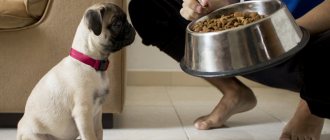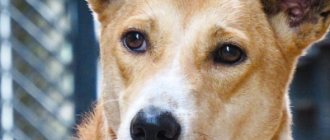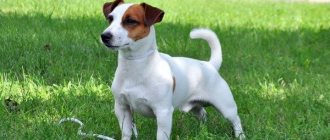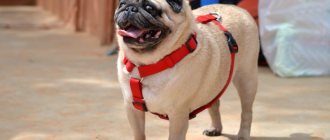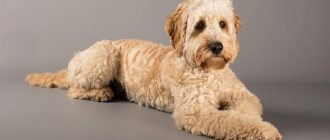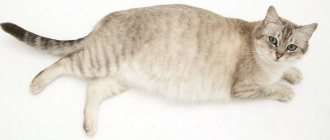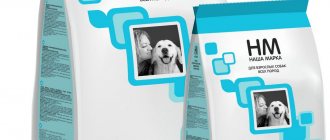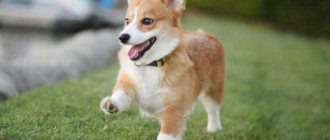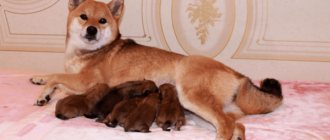Ears, teeth and claws
Pug ears require special attention and care due to the breed's tendency to get ear infections. To maintain cleanliness and prevent disease, ears must be cleaned as they become dirty - approximately once every 2 weeks, using:
- boric alcohol;
- 3% hydrogen peroxide;
- a special lotion that can be purchased at any pet store.
Having chosen a product, you need to moisten a cotton pad in it, squeeze it out and carefully clean the folds of the ear so that there is no hair, dust or dirt left on them. You should also place a couple of drops in the pug’s ears, massage them for half a minute, and then use a cotton swab to clean the inside of the ear.
An unpleasant odor coming from a dog's ears is a symptom of otitis media or infection. And black dirt and itching may indicate ear mites.
Dental health is a very important point in a dog’s life. Therefore, brushing your teeth is one of the mandatory hygiene procedures.
To remove plaque from a young dog’s teeth, you can contact a veterinarian who will perform the procedure under anesthesia.
However, this method is unacceptable for dogs over 7 years old, since their hearts are unlikely to tolerate anesthesia. To clean the teeth of dogs of any age, use a special toothpaste and brush.
At home, you can use a terry cloth soaked in a solution of baking soda. You should fix the pet's head, carefully lift the upper lip and begin cleaning. In addition, you need to give your dog special treats sold in pet stores and pharmacies.
To care for claws, you need a special nail clipper, with which, in order to avoid creases and delamination, you should trim the dog’s nails as they grow - about twice a month. The procedure must be carried out carefully so as not to touch living tissue. Otherwise, cutting the nail short will cause pain to the dog and may cause bleeding. Claws that are trimmed at the wrong time will interfere with the pug's movements and can lead to deformed toes.
Wool
The good condition of the pug's coat is responsible for its neat appearance. You need to bathe your dog only when necessary - frequent washing can cause harm to the pet, since the pug's skin is covered with a biologically active film, which, when washed off, causes the skin to become covered with dandruff, and the hair becomes brittle and dull.
When washing, you need to cover the dog's ears with cotton swabs and protect the eyes. It is necessary to use a special shampoo for short-haired dogs, choosing which should be based on the characteristics of the skin and the condition of the coat. After the procedure, you should wipe the pug dry, give it a shake and dry it with a hairdryer. comb your pet with a stainless steel iron comb every week, and daily during shedding.
The fur near the mouth should be combed carefully, and the ears should not be touched.
A haircut
Pugs have a short coat, however, from time to time they need a partial haircut to make grooming easier.
In addition, a haircut is a prerequisite for a pug to participate in exhibitions or competitions, as well as in the presence of skin diseases, fungal infections, cuts and abrasions.
The most common option for cutting a pug is to shorten the hair along the body by 1.5 cm and straighten the hair on the “pants” and tail with thinning scissors. The fur is trimmed with a special clipper in the direction of hair growth.
Because the coat is too short, the pug's skin becomes vulnerable and prone to burns. Therefore, it is necessary to carefully care for it using various moisturizing creams and lotions.
Eyes
Pug eyes are often susceptible to various diseases and require regular care. It is necessary to constantly monitor their condition and wipe them in time. Daily you need:
- check the corners of the eyes and clean with a damp soft cloth or cotton pad
- accumulation of secretions;
- control the intensity of tear production and the general condition of the eyes;
- monitor your pet while walking to avoid mechanical damage;
- Avoid drafts and exposure to strong air flow.
It is also important to ensure that water does not get into your pug's eyes when bathing. Also, while walking, he should not come into contact with sick animals. If, during a morning check, greenish-yellow mucus is found in the pug's eyes, this is evidence of a possible infection. Crust on the eyelids and sticking of the eye or both eyes are signs of conjunctivitis. Puffiness and swelling indicate an eye injury, an insect bite or an allergy.
If any of these symptoms are detected, you should contact a veterinarian as soon as possible , but your home medicine cabinet must have the necessary medications to provide first aid to your pet.
Prohibited Products
In order to correctly and clearly answer the question of what can be fed to pugs, it is necessary to indicate what is completely contraindicated for them.
- First of all, it is necessary to completely exclude pasta and noodles from the diet and never taste them.
- Semolina porridge, especially with some kind of gravy.
- It is absolutely unacceptable for your dog to eat potatoes - this is a sure way to diabetes.
- The ban also applies to sweet products and confectionery.
- It is unacceptable to give sugar and its modifications and substitutes.
- It is strictly forbidden to treat children with flour products and bread.
- Other prohibited products include all types of smoked and pickled foods, as well as semi-finished products.
Treatment of skin folds
Multiple folds on the pug's face require careful care, especially in the warm season.
After eating and walking, bacteria accumulate in them, which can cause an unpleasant odor and the development of fungal diseases or infections.
In addition, they can rot, causing the dog to develop irritation and dermatitis.
It is necessary to wipe the pug's folds twice a week with a cotton swab dipped in a special lotion that does not contain alcohol. First of all, you should wipe the area under the eyes, and then all the folds on the face. After the procedure, the skin under the nose should be lubricated with olive oil or Vaseline. In the cold season, this procedure can be reduced to 1 time per week.
Host Responsibilities
Procedures that a pug owner should carry out daily:
- examine the eyes;
- control the purity of the water in the bowl;
- walk the animal twice a day;
- Brush his fur regularly.
Expert opinion
Anna Abramenko
An avid dog lover. Experience in veterinary medicine since 2009.
Ask a Question
Also, the owner should wipe the folds of the animal’s muzzle, brush its teeth and ears every day. Bathe him monthly and trim his nails. Once a season, carry out antiparasitic therapy and take him for examination to a veterinarian.
Cloth
The range of clothing designed for small breeds of dogs is quite wide.
It includes sweaters, overalls and even modern hooded sweatshirts.
Any clothing suits pugs, and the choice depends only on the character of the dog and the taste of the owner.
However, we must not forget that dressing a pug is not for fun.
First of all, it is needed to preserve his health.
Representatives of this breed cannot tolerate cold, so they need to be well insulated before a walk. In addition, when buying clothes for a dog, you should choose one that will not hinder its movements, prevent hypothermia and will be easy to clean.
Walk
Pug puppies benefit from frequent and long walks, while adult dogs only need short walks 1-2 times a day.
It is necessary to monitor the condition of the dog while walking.
Avoid overheating or freezing; in case of bad weather, you should shorten your walk as much as possible.
Despite the recommendations, the regularity and duration of pug walks depends only on the owner and his desire to walk the pet.
After all, these dogs do not need long walks and, if they have the desire, they can be trained to use a tray.
Due to breathing problems, it is better to refrain from walking in too hot or cold weather.
Post-walk inspection and paw washing
To avoid the occurrence and development of various problems, the pug must be carefully examined after each walk.
A thorough examination of your pug's eyes should be performed at any time of year.
During a walk, they can be damaged even by a dry blade of grass or subject to insect bites.
In the spring and summer, the dog must be checked for the presence of ticks, which can stick to the stomach or paws.
Washing your paws after a walk is a mandatory procedure, which requires a special paw brush. You can also remove dust and dirt from your paws by wiping them with damp wipes. The folds on the pug's face require special attention, into which ticks can crawl, dust and dirt can become clogged, which can lead to serious problems.
Necessary purchases
To care for a pug puppy you need the following equipment:
- bed and warm cape;
- warmer;
- two bowls;
- disposable diapers;
- litter tray;
- special toys for dogs;
- collar or harness, leash;
- muzzle (for an adult);
- shampoo;
- nail clipper;
- comb for wool;
- drops for eyes and ears;
- Toothbrush;
- cotton swabs, wet and dry wipes.
Nutrition
Pugs have small stomachs that are not adapted to liquid food. When choosing to feed natural food, you must include in your pug’s diet:
- lean meats;
- beef offal;
- sea fish fillet;
- fruits, herbs and vegetables;
- milk;
- fermented milk products;
- cereals – buckwheat, oatmeal.
Caloric content and nutritional composition are adjusted depending on the season and the general health of the dog.
The advantage of dry and canned food is ease of storage and the ability to calculate the daily requirement as accurately as possible.
The products are adapted for dogs of any age, as well as for pets prone to allergies, overweight or with digestive problems.
When purchasing, you should give preference to holistic and super-premium food. You should avoid feeds that do not contain vegetables and contain chicken, rice, dyes and flavor enhancers.
Violation of the rules of nutrition and diet of pugs leads to digestive problems and obesity.
Vitamins
A lack of vitamins usually occurs when feeding a pet natural products and can lead to negative consequences. Vitamins a pug needs:
- vitamin A – important during the growth and development of the dog, as well as during mating, pregnancy, and lactation;
- B vitamins – needed for muscle development, affect the health of the skin and coat;
- vitamin C – serves to prevent diseases of the gums and joints, increases the body’s resistance to colds;
- Vitamin D – protects against rickets, strengthens bones and tendon ligaments.
Also, with a natural diet, pugs should be given calcium..
After 7 months Pug
From this age, the pug's feeding should be reduced and given only twice a day - respectively, in the morning after sleep and in the evening before bed. Morning feeding can include the entire diet listed above, and thanks to its diversity, it will not be difficult to decide what food to feed the pug, and each time add some variety to it. However, it is important to remember that fish products in combination with meat should be served exclusively in the second meal, that is, in the evening.
From the age of 8 months, the puppy can be switched to full-fledged adult food. When feeding naturally, it is very important to add the necessary vitamins and minerals to your pet’s diet, which are now available in a wide range in veterinary pharmacies. It is best, of course, before you start taking any drug, to consult a veterinarian about it, otherwise no one will guarantee that it will not cause an allergic reaction in your pet. The need to switch to ready-made food should occur gradually; in no case should natural food be eliminated immediately - it is necessary to move away from it gradually.
ANATOLIAN SHEPHERD DOG: BREED STANDARD AND ORIGIN OF THE DOG
JACK RUSSELL TERRIER: ORIGIN OF THE BREED AND CHARACTER OF THE DOG
HISTORY OF THE BREED AND CHARACTER OF THE SAMOOED DOG
GOLDEN RETRIEVER: HISTORY OF ORIGIN AND CHARACTER
Dog vaccination
It is necessary to prevent the development of infectious diseases that threaten the life and health of the pug.
In addition, without vaccinations, a dog cannot participate in exhibitions or travel abroad.
Conducted only for completely healthy dogs. The first vaccination should be given at about 2 months of age, the second - after 3 weeks.
After changing teeth, a second course of vaccinations is carried out, then it is repeated annually.
10 days before the first vaccination it is necessary to carry out deworming. You can walk your pet only 1.5 weeks after the second vaccination.
